In order to gain a better understanding of tax credits, I met with the tax credits subject matter expert (SME) and product owner (PO) to discuss the client's current experience, the ADP associate's current process, and the project scope for Incentive Manager's MVP. Using the information I gathered during these discussions, I mapped out user flows of the current experience for clients & ADP associates as well as what the ideal MVP experience should be.
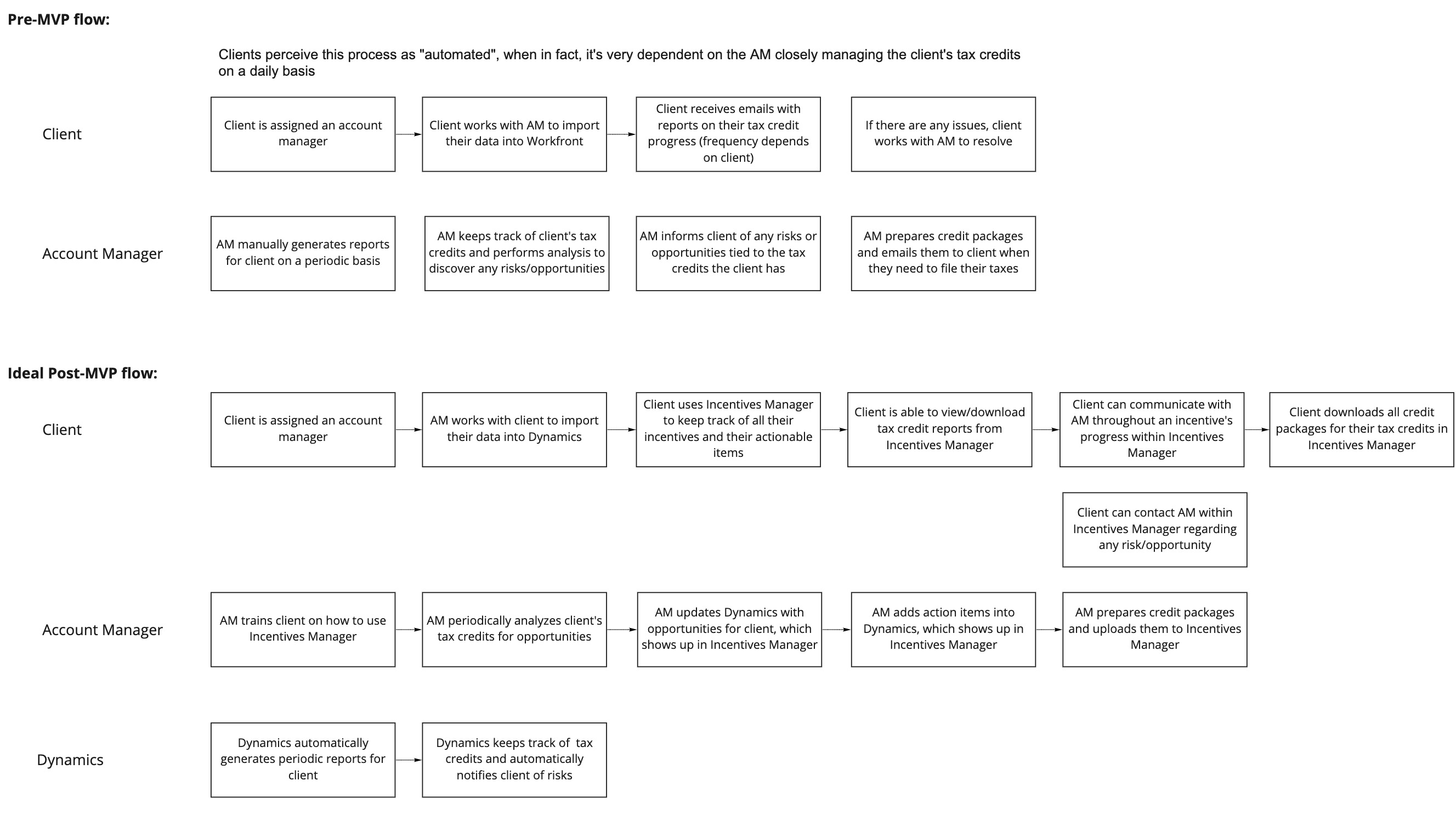
The following MVP requirements were finalized with the SME and PO:
Eventual replacement of the current tax credits workspace. The dashboard page will be a client’s entry point to their incentives portfolio by providing a visualization of year-to-date portfolio values with the potential to show a breakdown of these values by tax year. This page will also inform clients about potential risks and opportunities within their portfolio.
Displays all incentives of a client’s portfolio and allows them to drill down into each incentive’s YTD values, status, potential risk/opportunity, and progress. Incentives will be grouped by Above Line or Below Line.
Provides more insight on each progress step for an incentive and allows clients to communicate with their ADP associate through the Notes feature.
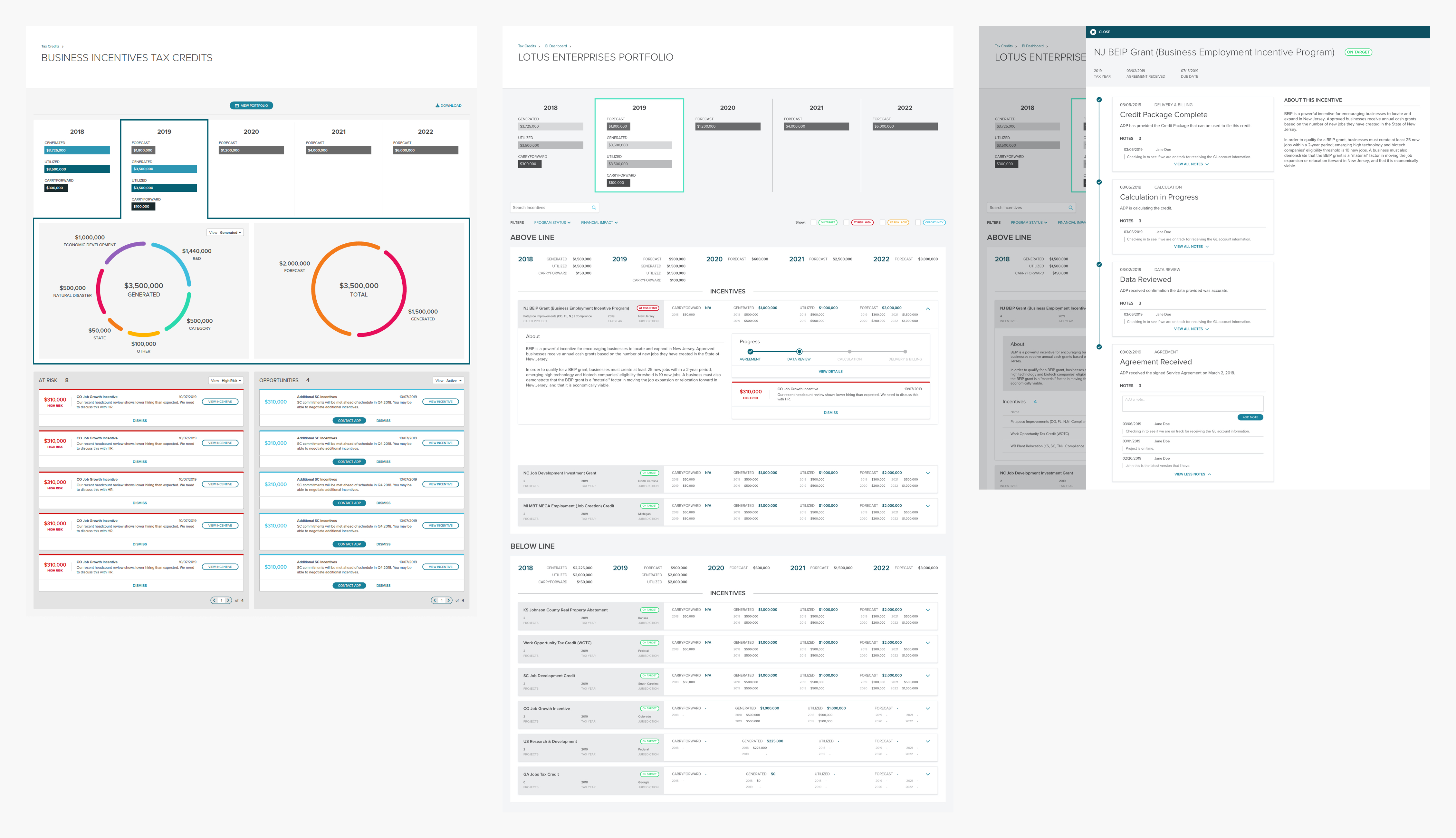
Before moving onto mockups, I collaborated with one of our UX researchers to organize usability sessions with a couple of our clients to do some validation on my wireframes. This included creating a moderator guide, reaching out to ADP associates for their client lists, scheduling clients, and moderating the sessions. Each testing session was 60 minutes and consisted of one-on-one interviews followed by a usability test using an Invision prototype.
A challenge we encountered was the primary user group the wireframes were designed for, tax directors & administrators participating in ADP’s business incentives program, were very difficult to recruit. Therefore, we had to recruit from a secondary user group identified: mostly HR practitioners with experience in SCP and ADP’s WOTC program.
Utilizing the findings from our first round of usability sessions, I began working on the MVP mockups. The following screens were finalized after multiple design reviews with the SME and PO.
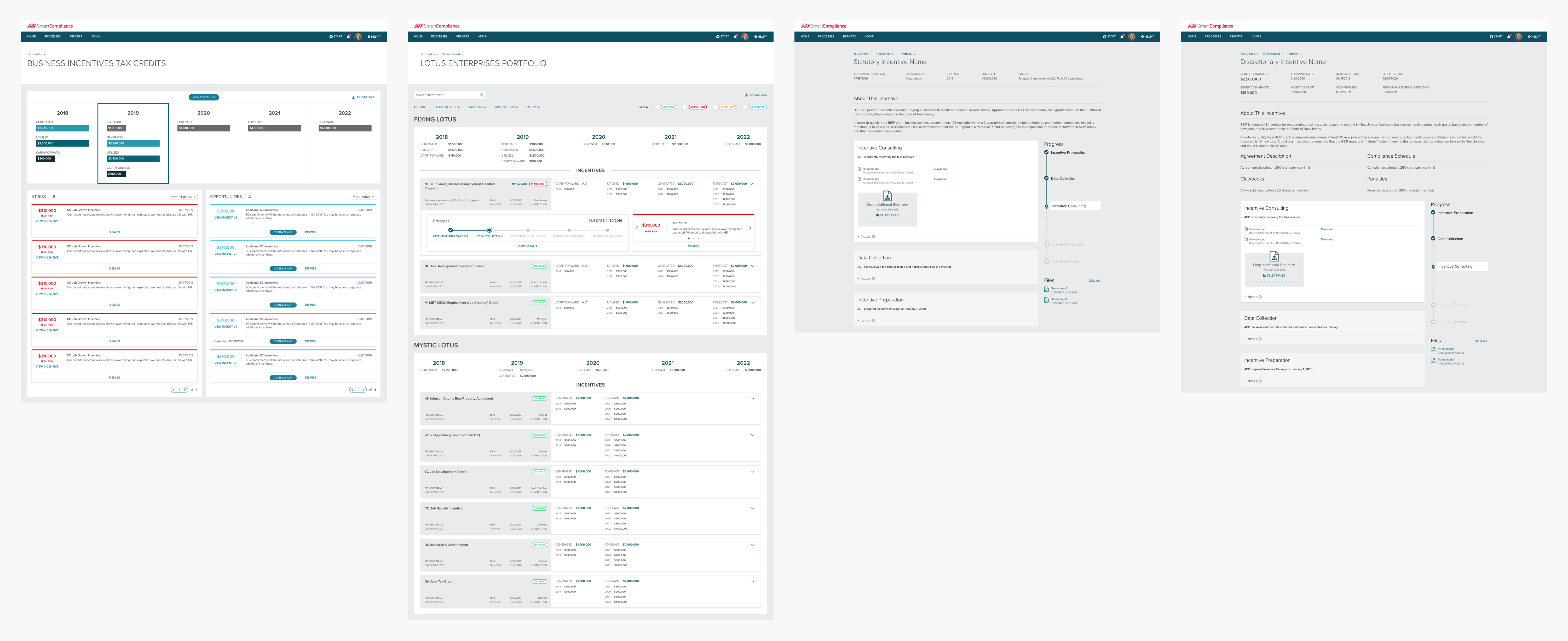
We were able to do another round of usability sessions after the MVP went live. A challenge we had in the last round was recruiting the primary user group, however after clients and associates had a chance to use Incentives Manager within SCP, we were able to schedule sessions with clients in the primary user group.
It was interesting to see the polarity between the responses of the first and second rounds of usability sessions. I met with the SME and PO to review our roadmap and discuss what changes needed to be made to accommodate the feedback we had received. Upon further discussion, I learned that the MVP was created based on the SME’s knowledge of a certain group of clients which only made up 2% of Incentives Manager's client base. The participants we interviewed in the usability sessions were not a part of that 2%.
We agreed that before we could proceed with further updates to Incentives Manager, we needed to identify what user groups are using the product and what their top tasks are.

Within these four segments, Down-Market and WOTC clients make up the majority of Incentives Manager users and all usability session participants belonged in those two segments. The SME stated that the MVP requirements we agreed upon were centered around EDS clients that have different data requirements for their incentives portfolio. Therefore, it made sense that the clients we interviewed did not feel the MVP experience was showing what they needed.
In addition to the four user segments, we separated our clients into two categories:
clients with less than 10 incentives; can be any combination of the above segments
clients with more than 10 incentives; can be any combination of the above segments
These categories will help us determine what content to surface within Incentives Manager and how the UI will change based on the amount of incentives data shown. We already have a good idea of the top tasks for Down-Market and WOTC clients from our usability sessions, so I focused on brainstorming the top tasks for Up-Market and EDS clients with the SME and PO.
Gathering requirements for a redesign of Incentives Manager would take some time, so I began working on two updates that the PO and I felt were easy wins: adding Action Items & updating Opportunities. We had enough data from the ERP database to work off of and we already knew from our usability sessions that Down-Market and WOTC clients wanted these features.
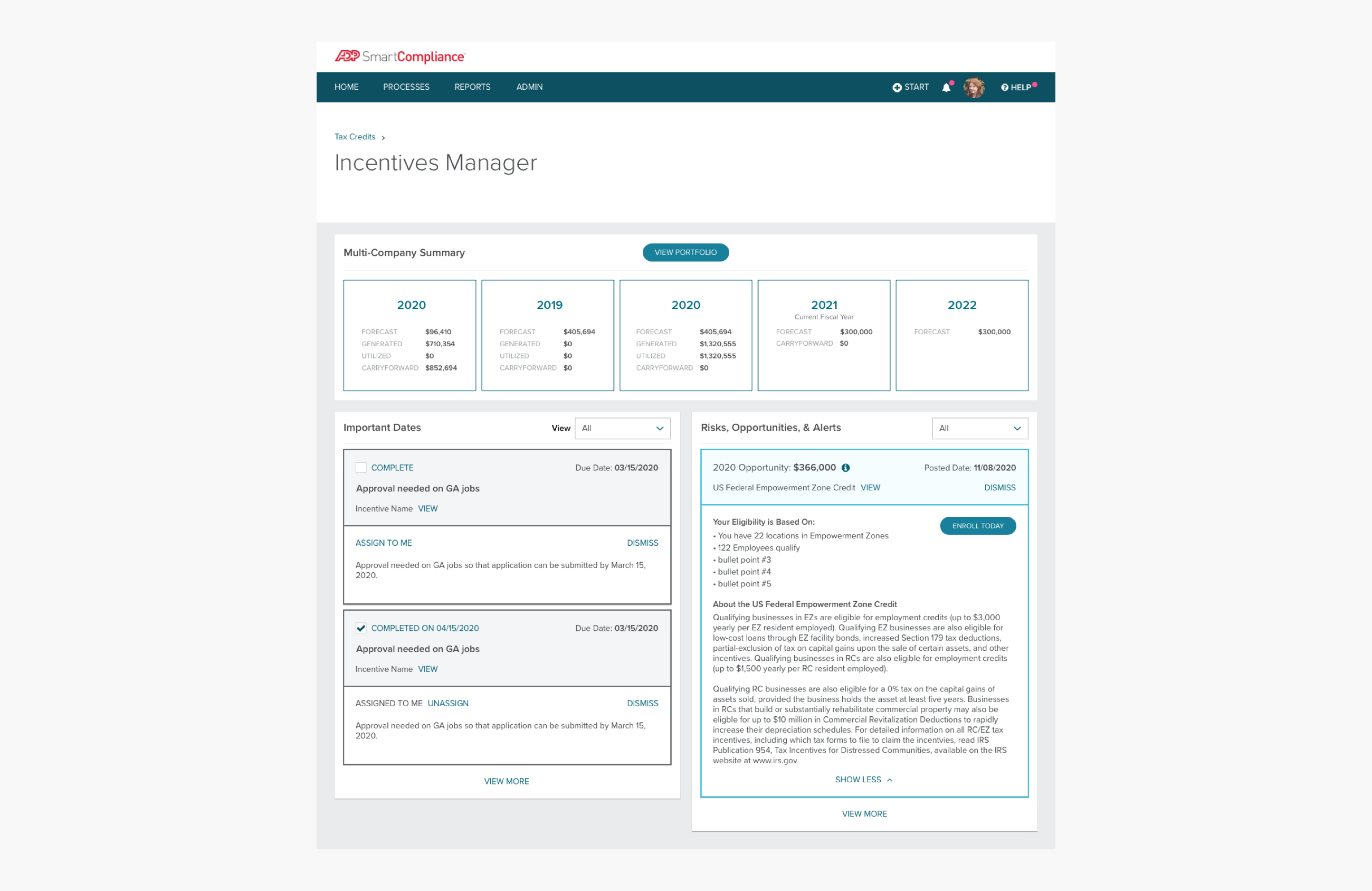
Action Items are essentially to-do items for a client's incentives grouped under a section called Important Dates. Opportunities were updated to provide information, such as eligibility information, that would help decision makers decide which opportunities to pursue. I also worked with the PO to design an email digest that would be sent out to clients alerting them of new opportunities.
In order to validate the recent updates made to opportunities, the PO and I decided to run a couple of usability sessions with WOTC Only clients. This user segment was recently given access to Incentives Manager and belonged to a different business segment of tax credits. Therefore, these clients would provide great insight on what opportunity information would drive them towards enrolling in business incentives. Also, one of our long-term goals is to replace the current workspace with Incentives Manager, so we needed to understand what data WOTC clients need to complete their daily tasks and the frequency in which they access this information within SCP.
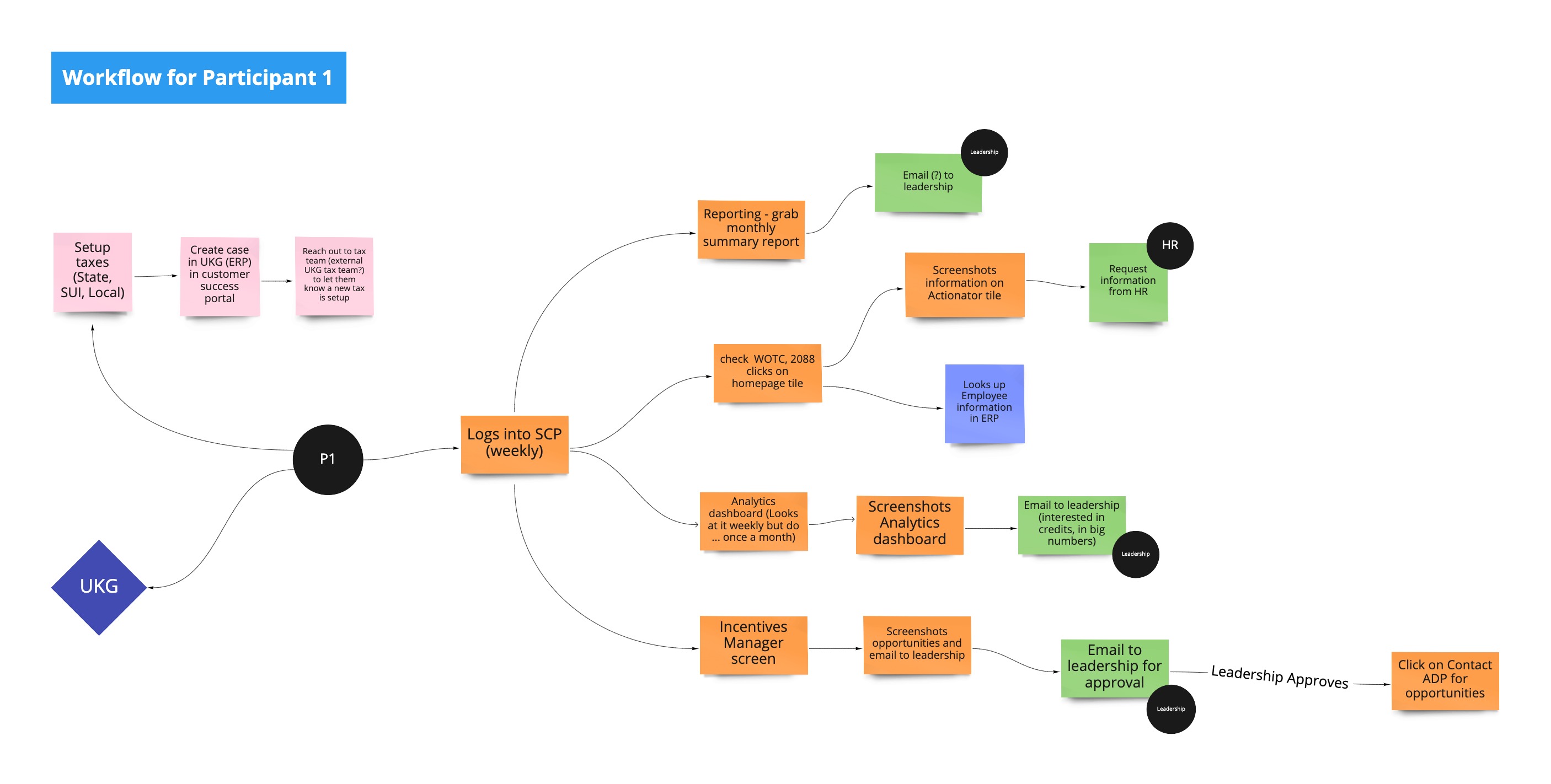
During this round of usability testing, I introduced a new activity for mapping out a participant's current process within Miro, an online collaborative whiteboarding platform. Team members assisting with note taking during a usability session would use Miro to map out a client's user flow on the fly. We would then use these user flows to aid in discussions during our debriefs where we affinity map our notes and determine what areas we still need clarity on.
The next step for Incentives Manager is to update the product so that relevant data is displayed based on user segment and top tasks. The PO and I decided to focus on creating a specific dashboard view for low volume clients mainly because we had the most data on this specific category and it is easier for us to validate designs with these clients. While finalizing requirements, I introduced a new activity called breadboarding into my UX process. The user flows I had been creating before did not allow me to gain a deep understanding of how components within the product connect with each other. I also wanted to break a habit the SME and PO have where they would create their own wireframes and present them as final requirements. I noticed that during our meetings we would mainly focus on how the product would look rather than how the product would work. Breadboarding allowed us to see the top-down plan for the entire product while we are figuring out what’s going in it.
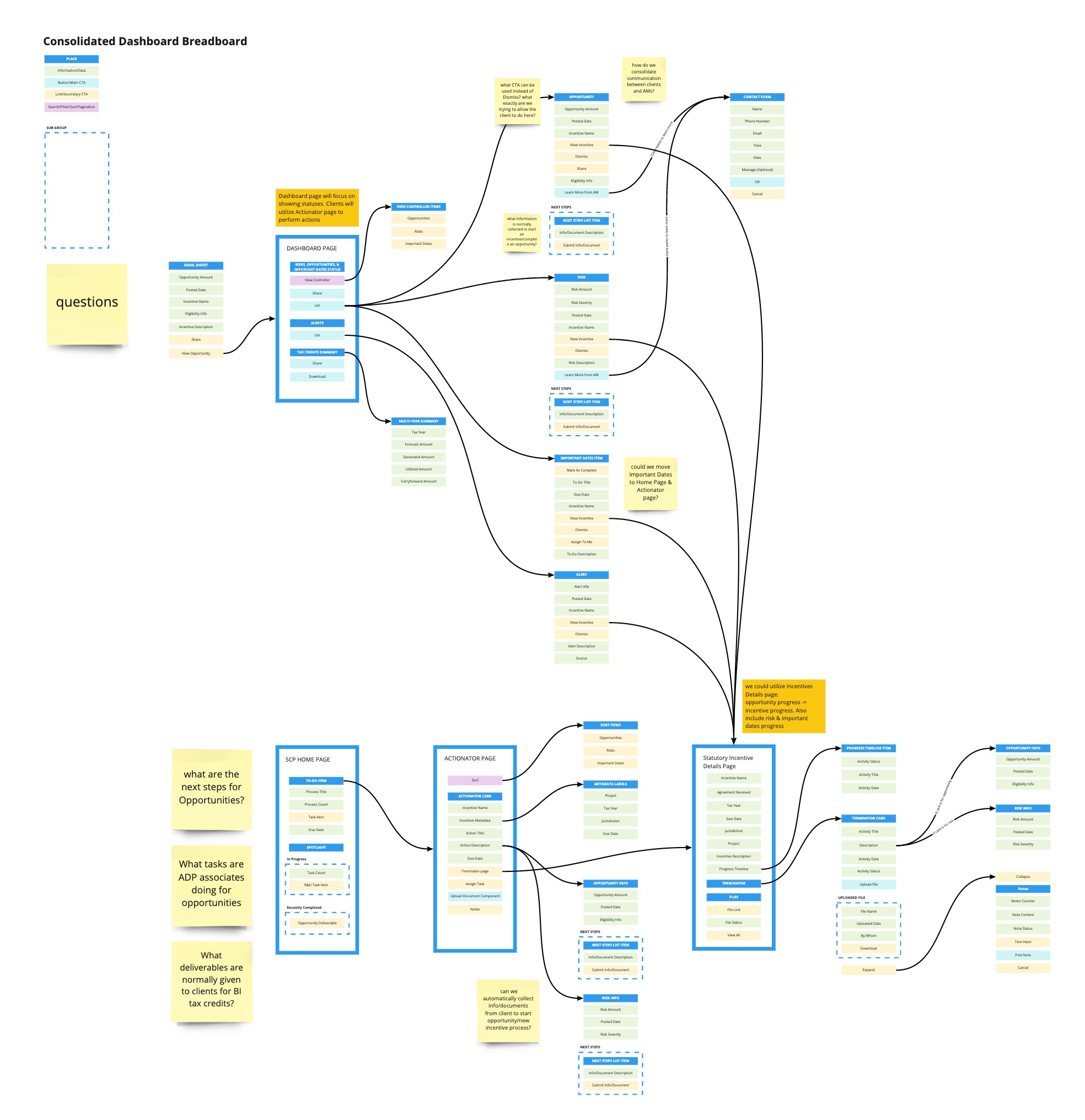

While working on the consolidated dashboard, I wanted to validate a couple of explorations I have been working on. Unfortunately, we were unable to schedule any clients for usability sessions due to tax season. I met with our UX researcher to brainstorm what alternative UX research methods we could use to obtain feedback and decided to create an A/B test within Pendo, our product analytics software. By placing the A/B test within a Pendo guide, we were able to choose where the guide showed up within Incentives Manager as well as what user segment would be able to view the guide. Using this method, we were able to obtain a good amount of responses that helped determine which exploration our low volume clients resonated with the most.
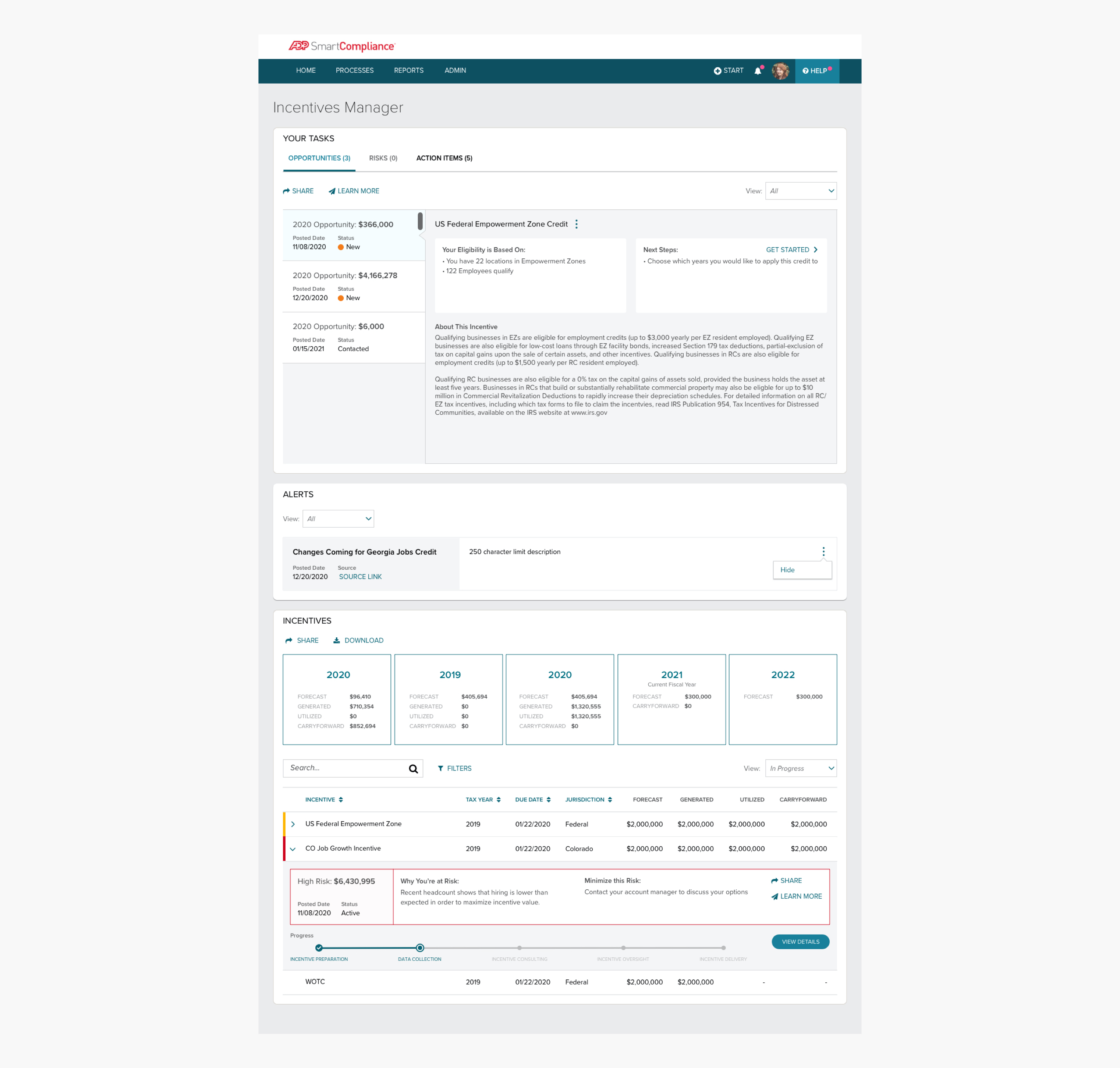
The original design for Risks and Opportunities no longer worked as we discovered through our usability sessions that clients wanted to see more information such as what steps they could take to minimize a risk/pursue an opportunity. They also prioritized tasks they could work on that would maximize the tax credit amount received from their incentives.
After I handed off the consolidated dashboard assets to the development team, I met with the SME and PO to begin discussions on a specific feature for our EDS clients called Projects. These clients make up 2% of Incentives Manager’s user base, however they manage a huge amount of incentives and are a top priority for business and sales.
EDS clients maintain an additional type of incentive called discretionary incentive within their portfolio. These incentives are typically grouped into projects that are managed by an ADP associate and negotiated with federal or state governments to outline the project's purpose and what commitments the company needs to fulfill in order to generate credit. Each project will be different based on what’s been negotiated. Because these aren’t necessarily standard incentives, the roll up of tax credits for a project is called a Benefit. Whether the client does all the necessary things to generate the total awarded or not is dependent on the incentive agreements.
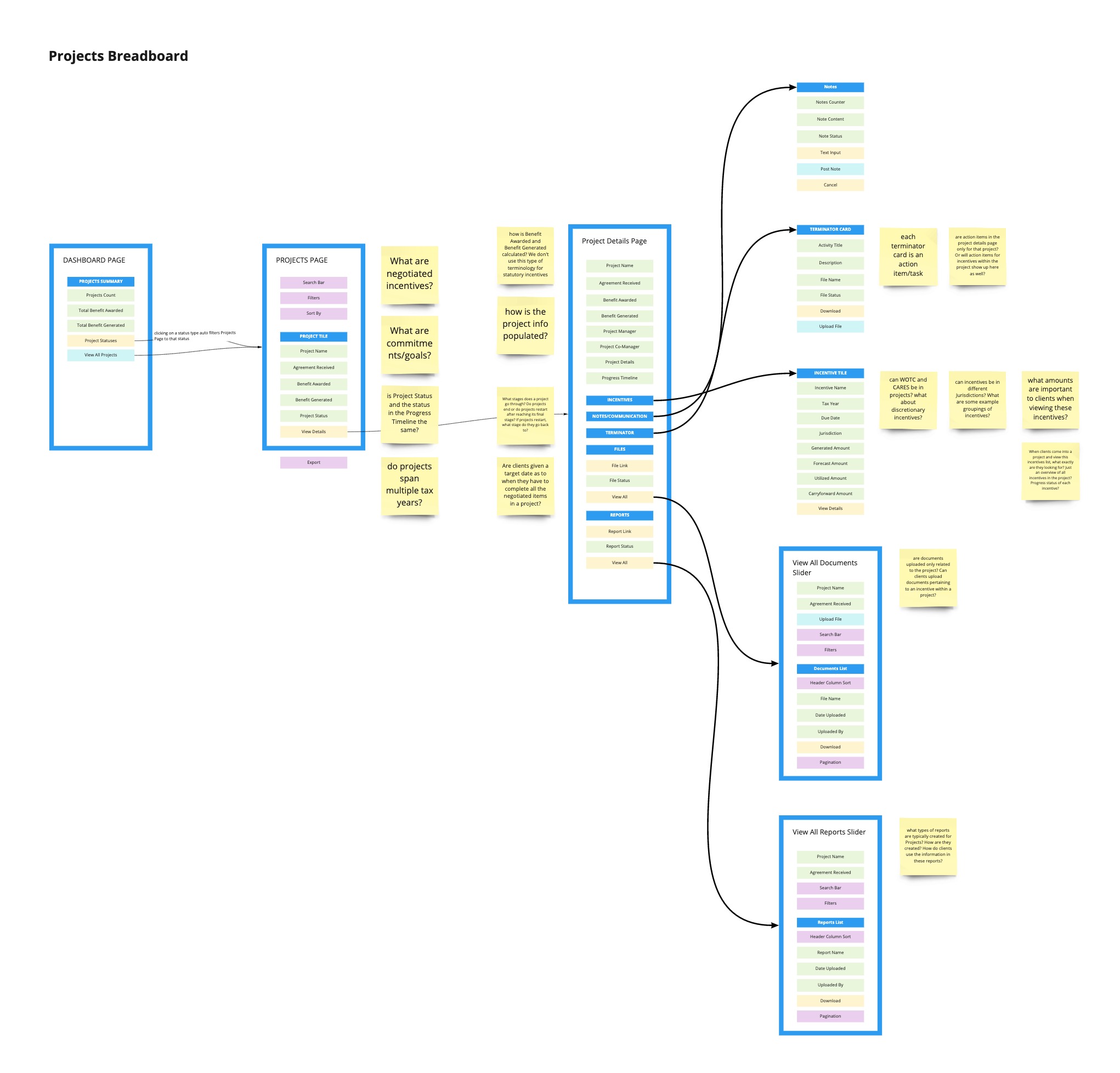
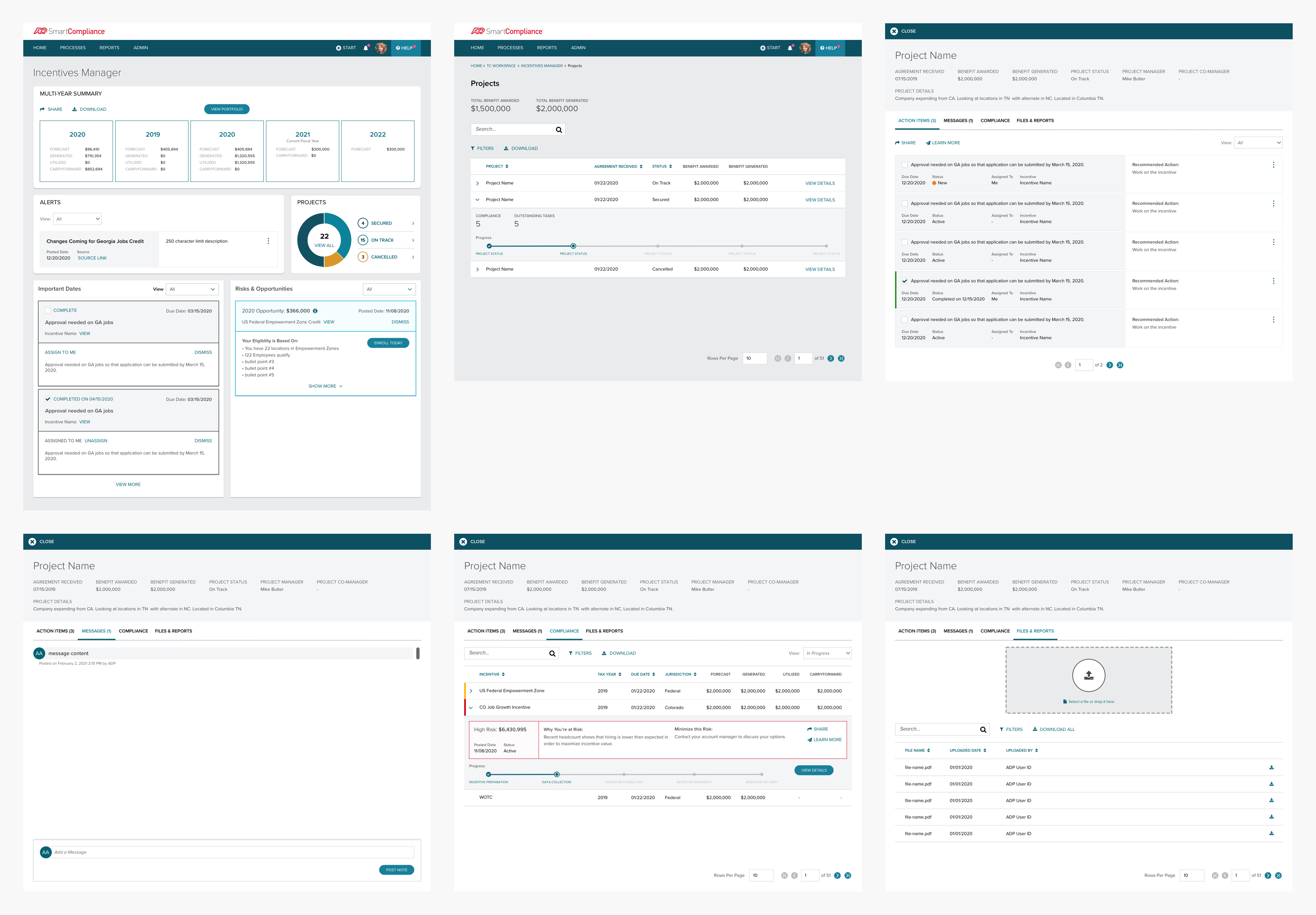
Created a Projects tile that shows project count and project status. Also included a couple of updates from the Consolidated Dashboard.
Utilizing a new page template from the SCP design library, the Projects page provides an overview of a client's projects. Each project row shows a project's status, YTD values, and progress. Clients can also view more information about a project via the project details slider.
Provides a singular area where a client can view detailed information and work on tasks assigned to the project. Includes a new communications component that will eventually replace Notes within Incentives Manager. Client can also drill down into each secured incentive's YTD values, status, potential risk/opportunity, and progress.
Unfortunately, requirements were not finalized for Projects until two weeks prior to the development team’s scheduled sprint for this feature. I was able to breadboard the requirements, create the mockups, and obtain some internal feedback from the SME before handing off the assets to the development team. I still plan to validate these designs with EDS clients and am currently working with our UX researcher to schedule usability sessions.